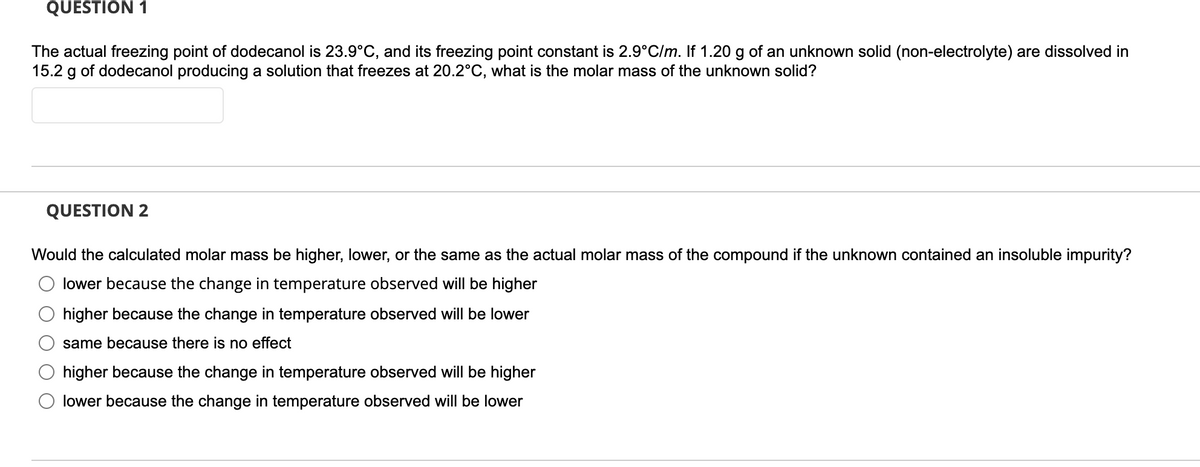QUESTION 1 The actual freezing point of dodecanol is 23.9°C, and its freezing point constant is 2.9°C/m. If 1.20 g of an unknown solid (non-electrolyte) are dissolved in 15.2 g of dodecanol producing a solution that freezes at 20.2°C, what is the molar mass of the unknown solid?
QUESTION 1 The actual freezing point of dodecanol is 23.9°C, and its freezing point constant is 2.9°C/m. If 1.20 g of an unknown solid (non-electrolyte) are dissolved in 15.2 g of dodecanol producing a solution that freezes at 20.2°C, what is the molar mass of the unknown solid?
Chemistry: The Molecular Science
5th Edition
ISBN:9781285199047
Author:John W. Moore, Conrad L. Stanitski
Publisher:John W. Moore, Conrad L. Stanitski
Chapter13: The Chemistry Of Solutes And Solutions
Section: Chapter Questions
Problem 127QRT
Related questions
Question

Transcribed Image Text:QUESTION 1
The actual freezing point of dodecanol is 23.9°C, and its freezing point constant is 2.9°C/m. If 1.20 g of an unknown solid (non-electrolyte) are dissolved in
15.2 g
of dodecanol producing a solution that freezes at 20.2°C, what is the molar mass of the unknown solid?
QUESTION 2
Would the calculated molar mass be higher, lower, or the same as the actual molar mass of the compound if the unknown contained an insoluble impurity?
lower because the change in temperature observed will be higher
higher because the change in temperature observed will be lower
same because there is no effect
higher because the change in temperature observed will be higher
O lower because the change in temperature observed will be lower
Expert Solution
This question has been solved!
Explore an expertly crafted, step-by-step solution for a thorough understanding of key concepts.
This is a popular solution!
Trending now
This is a popular solution!
Step by step
Solved in 4 steps

Knowledge Booster
Learn more about
Need a deep-dive on the concept behind this application? Look no further. Learn more about this topic, chemistry and related others by exploring similar questions and additional content below.Recommended textbooks for you

Chemistry: The Molecular Science
Chemistry
ISBN:
9781285199047
Author:
John W. Moore, Conrad L. Stanitski
Publisher:
Cengage Learning

Introduction to General, Organic and Biochemistry
Chemistry
ISBN:
9781285869759
Author:
Frederick A. Bettelheim, William H. Brown, Mary K. Campbell, Shawn O. Farrell, Omar Torres
Publisher:
Cengage Learning

Chemistry: An Atoms First Approach
Chemistry
ISBN:
9781305079243
Author:
Steven S. Zumdahl, Susan A. Zumdahl
Publisher:
Cengage Learning

Chemistry: The Molecular Science
Chemistry
ISBN:
9781285199047
Author:
John W. Moore, Conrad L. Stanitski
Publisher:
Cengage Learning

Introduction to General, Organic and Biochemistry
Chemistry
ISBN:
9781285869759
Author:
Frederick A. Bettelheim, William H. Brown, Mary K. Campbell, Shawn O. Farrell, Omar Torres
Publisher:
Cengage Learning

Chemistry: An Atoms First Approach
Chemistry
ISBN:
9781305079243
Author:
Steven S. Zumdahl, Susan A. Zumdahl
Publisher:
Cengage Learning


Chemistry
Chemistry
ISBN:
9781305957404
Author:
Steven S. Zumdahl, Susan A. Zumdahl, Donald J. DeCoste
Publisher:
Cengage Learning

General, Organic, and Biological Chemistry
Chemistry
ISBN:
9781285853918
Author:
H. Stephen Stoker
Publisher:
Cengage Learning